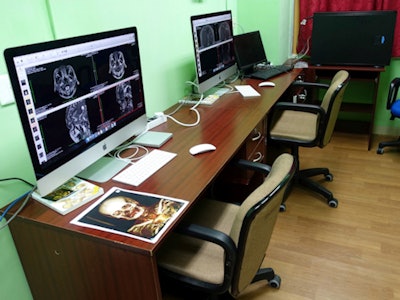
Open-source software can be an effective way to facilitate image interpretation, archiving, and distribution, particularly in developing countries that lack the IT infrastructure and cash to adopt digital image management, according to Dr. Osman Ratib of the University Hospital of Geneva.
Ratib and his colleagues recently installed an open-source imaging informatics platform at the main hospital in Bhutan's capital of Thimphu, enabling the institution to experience many clinical and workflow benefits.
"Radiologists were rapidly capable of reading and interpreting studies on the diagnostic workstations, which had a significant benefit on their workflow and ability to perform diagnostic tasks more efficiently," the authors wrote.
Lacking IT infrastructure
While emerging countries have increasingly been adopting digital imaging modalities such as MR and CT, limited budgets often don't provide local institutions with enough funds to also implement IT infrastructures needed to support these imaging studies. That can pose a significant challenge.
The Jigme Dorji Wangchuck National Referral Hospital in Thimphu is the only radiology center in Bhutan that has a CT scanner, MRI scanner, digital radiography (DR) system, and a suite of five ultrasound systems, according to the Swiss team. After traveling to visit the institution, the team found, however, the hospital did not have the proper infrastructure for managing and viewing the imaging data from these modalities (Insights into Imaging, 28 July 2016).
"Images are interpreted directly on the scanner consoles located in the imaging suites, competing with the technologist's task of performing imaging procedures concurrently," the authors wrote. "Besides the physical dispersion of these devices requiring radiologists to move from one unit to another to review and interpret the studies, it has a significant impact on the workflow and efficiency of radiologists in their daily tasks."
Because the images weren't properly stored and archived on a PACS, image data had to be saved on individual CDs. Those can be hard to find, however, when a patient returns for a new study, according to the group. In addition, the hospital was experiencing a growing need to facilitate communication between radiologists, referring physicians, and clinical units.
"Distribution of medical images to clinical wards and directly to clinical partners is particularly difficult given that only a very limited number of images are being printed for economic reasons; reading images from CDs remains limited and cumbersome for referring physicians," the authors wrote.
The hospital did have a secure local area network, but did not have the proper software and infrastructure to easily and cost-effectively provide clinical access to images, according to the group.
Open-source technology
As a result, the Swiss team sought to deploy an open-source imaging informatics platform. They built a PACS server on a Linux-based 7048R-TR server (Supermicro) along with a software framework consisting of several open-source components:
- OpenMediaVault operating system for network-attached storage (NAS)
- Dcm4chee image manager software with a MySQL database
- Weasis Java-based viewer for clinical access to images
- OxiriX image analysis software for interpretation
A dedicated web-based graphical user interface allows for managing the PACS server and monitoring PACS activity. The operating system is installed on the solid-state drive disks, which are mirrored by a redundant array of inexpensive disks (RAID)-1 configuration. All archived images are stored in a RAID-5 virtual partition with six "hotswap" disks and two "hotspare" disks, according to the group.


Architecture of image management network installed at Jigme Dorji Wangchuck National Referral Hospital in Thimphu, Bhutan. All images courtesy of Dr. Osman Ratib.
Radiologists perform diagnostic interpretation on two 27-inch Apple iMac workstations with Retina display and the open-source OsiriX software.
 Radiologists at the hospital can now interpret studies in a dedicated reading room using one of two Apple iMac workstations and the open-source OsiriX software.
Radiologists at the hospital can now interpret studies in a dedicated reading room using one of two Apple iMac workstations and the open-source OsiriX software.The installation was completed over a three-day period in November 2015, and included onsite training of radiologists, technologists, sonographers, and IT staff, according to the group. A member of the hospital's IT team was designated as the PACS manager, who is responsible for managing, updating, and backing up the system.
 The three-day installation process included training for radiologists and other staff members.
The three-day installation process included training for radiologists and other staff members.All imaging orders and reports are currently handled on paper, as the hospital does not yet have a RIS, electronic patient record, or hospital information system.
"While OsiriX software supports the option of importing orders and generating diagnostic reports, it was implemented as a standalone PACS network for image viewing and analysis," the authors wrote. "It is, however, fully compatible with future deployment of RIS and HIS systems."
Used daily
Since the system was installed, the hospital's radiologists have been using the two OsiriX workstations on a daily basis for review and interpretation of CT, MR, and some ultrasound studies, Ratib told AuntMinnieEurope.com.
"All images are archived automatically from the scanners, and some are routed automatically to the workstations," Ratib said.
Surgeons and other physicians in the hospital can access the images through the Weasis web viewer, he said. Ratib noted the system is fully maintained by the local team in Thimphu.
"In addition, we have access remotely from here in Geneva and my colleague Nicolas Roduit was able to check on the system and also install software updates of the PACS remotely last month," he said.
The pilot project can serve as a model for a system "that can easily be disseminated in a large number of institutions around the world that already have digital imaging modalities but cannot afford the purchase and implementation of image management infrastructure and PACS systems," the authors wrote. "The PACS server architecture that we developed can be easily replicated on standard off-the-shelf hardware."



















